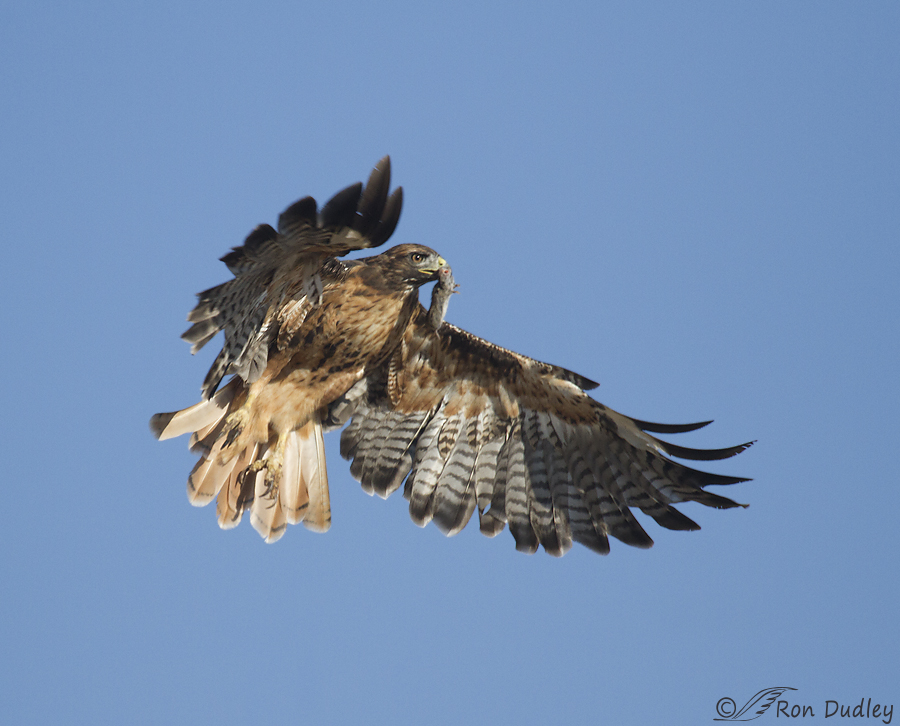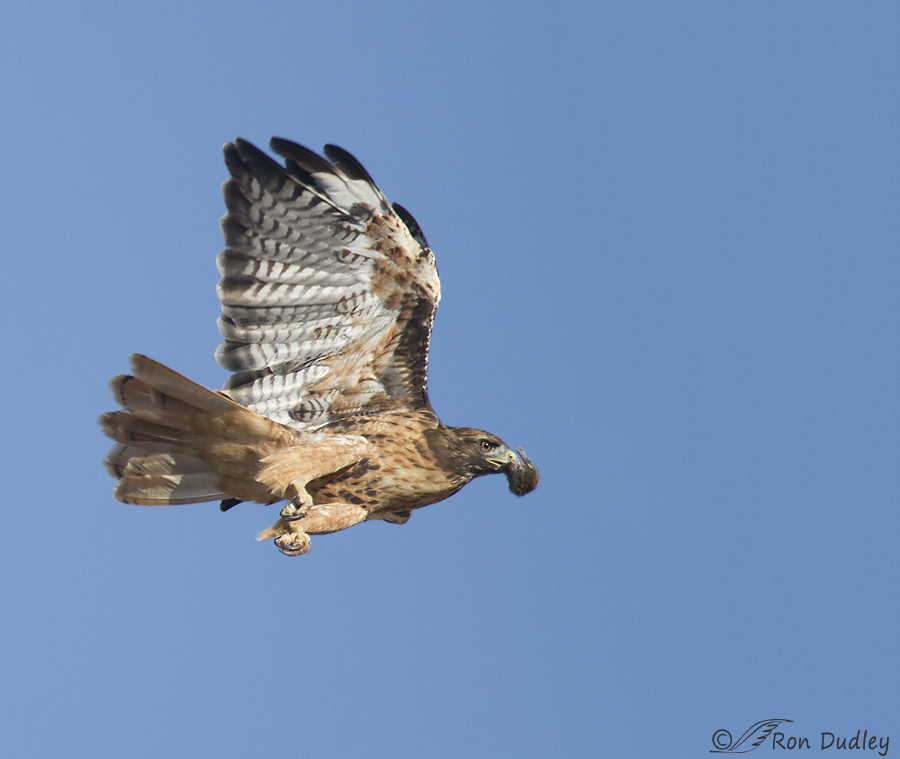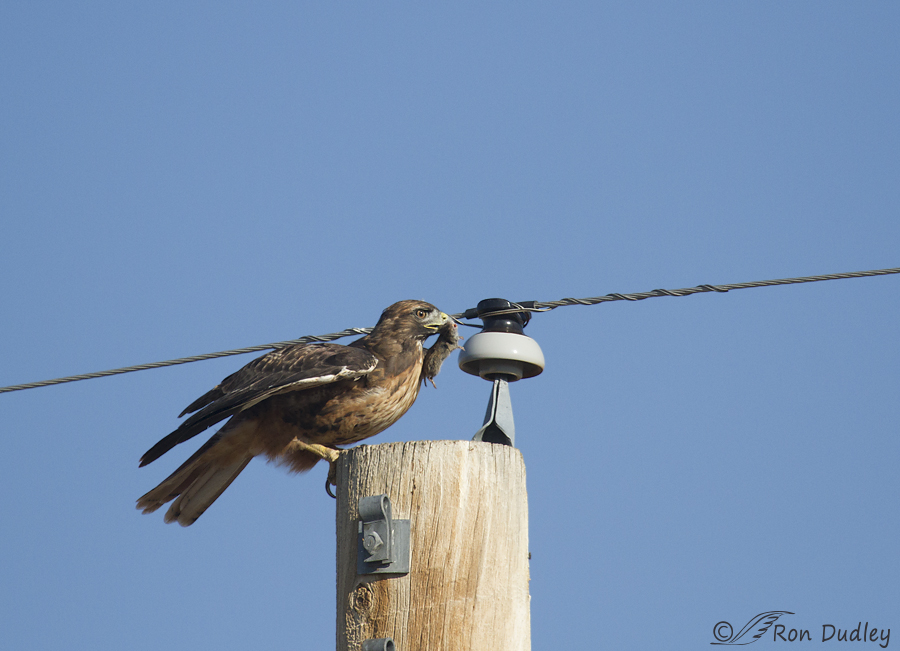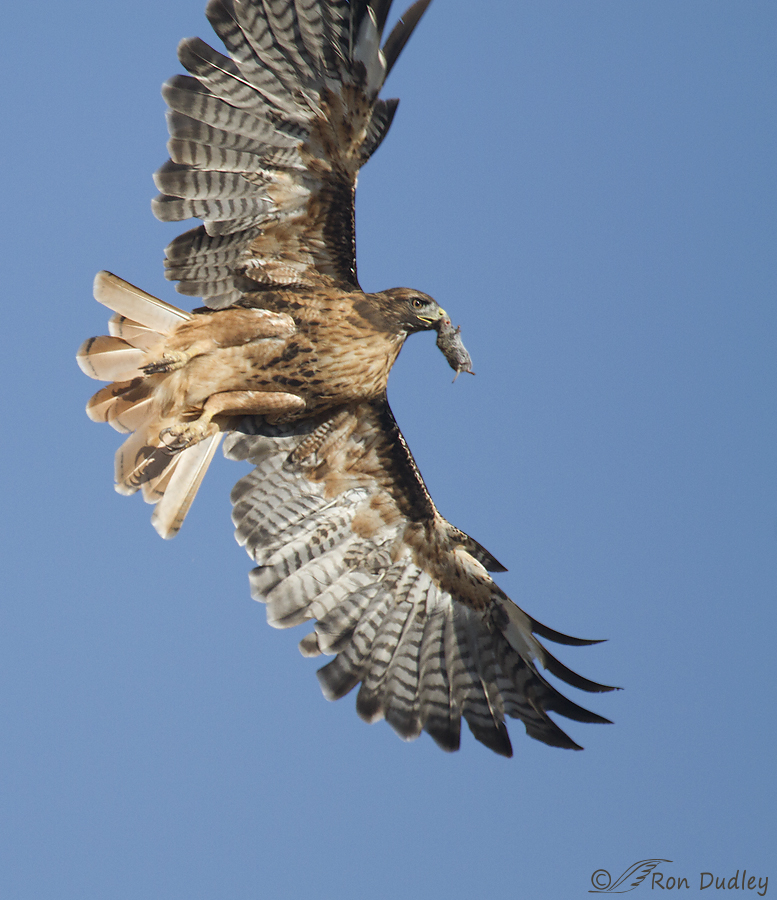In my experience Red-tailed Hawks in flight most often carry prey in their talons but this molting adult surprised me a little.
- Some of these images are less than tack-sharp but they do illustrate the behavior.

1/2000, f/6.3, ISO 500, Canon 7D, Canon EF100-400mm f/4.5-5.6L IS USM @ 400 mm, wire and insulator removed, not baited, set up or called in
I photographed this bird three days ago in Utah’s west desert as it took off with prey from a power pole. Just before it launched it picked up the rodent in its beak. Because of the short tail I believe the prey to be a vole but the lighter-colored belly made me think for a moment that it could be a mouse.
1/2000, f/6.3, ISO 500, Canon 7D, Canon EF100-400mm f/4.5-5.6L IS USM @ 400 mm, not baited, set up or called in
I was disappointed that I seriously clipped a wing when it banked just after take-off.

1/2000, f/6.3, ISO 500, Canon 7D, Canon EF100-400mm f/4.5-5.6L IS USM @ 400 mm, canvas added for composition, not baited, set up or called in
One more shot as the bird sped away.

1/2000, f/6.3, ISO 500, Canon 7D, Canon EF100-400mm f/4.5-5.6L IS USM @ 400 mm, not baited, set up or called in
I have a working theory as to why the hawk chose to carry the prey in its beak rather than its talons. This image was taken as the bird crouched to take off. I was shooting from the side of a busy road and I believe the bird wanted to take off away from the road and traffic but as you can see there was a wire in the way. To leave in that direction meant the wire had to be cleared – there was the danger of the left wing hitting the wire on the first flap.
So just before take-off the hawk picked up the prey it its beak and backed up on the post so that only its front toes were on top of the perch and its rear toes hung down below. I’m thinking that this toe configuration, sans prey, might give the bird more “spring” to clear the wire than if it took off flat-footed (think of the inefficiency of humans jumping flat-footed). It could have gone low to avoid the wire but it didn’t.
Sometimes I tend to over-analyze this kind of thing but it interests me so I let myself go with the flow. I’m certainly no raptor expert so I’m wondering if any of my readers (falconers or rehabbers, perhaps) know how unusual it might be (if at all) for these birds to carry prey in their beaks and if my theory as to why this hawk chose to do so sounds reasonable.
Ron



That Liguori guy sounds Iike he knows what he’s talking about! P:)
They need both legs to get the power to jump over the powerline at times or to get they height they prefer
I have seen a second year Redtail, heavily molting coincidentally, carry a mouse in its bill before landing to swallow it whole. It’s uncommon but I’ve seen similar behavior on at least 3 occasions. One of those was a prey transfer to a female on the nest after the male had eaten part of the prey.
PLEASE keep on analysing, questioning, sharing (too much of your analysis is barely enough). And I love seeing what the evil IPad does to Patty’s comments. Writhing has tickled my fancy today. Sadly my errors are all my own.
Thank you for all the responses, everyone. Perhaps this behavior isn’t even slightly unusual – I just didn’t know.
Dick, I agree that it’s a common behavior with Roughies as I’ve seen it quite a few times with them. And your guess as to why (relatively small feet) makes sense to me.
Hi Ron,
I have seen buteos carry prey in their beak on many occasions. In my experience, it has been when the bird was either eating or about to commence eating, and was either disturbed or somehow anticipated
someone or something (cars, other hawks, coyotes) getting too close. Since the bird either had the prey in its mouth or was about to put it there, it was the quickest way to depart. This is all anecdotal, of course, but I have seen it enough times to not be surprised. BTW, I have observed Rough-legged Hawks do this more frequently than their congeners – perhaps because of their tiny feet…?
Cheers,
Dick
That ‘s supposed to read “over analyzing”…the text on my iPad is so tsmall I can’t even see my mistakes when I’m writhing…only afterward…when it’s too late.
Patty, I don’t know what browser you use with your iPad, but in Safari, if you go to the advanced tab in preferences, you can specify the size of the type. In Firefox you can find it in preferences under the tab called content. In Google Chrome, it is in the ‘advanced’ section of the preferences (settings) page. Hope that helps. I, too, hate print that is too small to see (such as the way our local paper prints the NY Times crossword puzzles).
Forgot to mention that in Chrome, the advanced section is at the very bottom of the page.
You once showed us a vole or mouse biting the feet of the hawk carrying it…in one of these shots, it looks like the prey is curled up in such a position that it might be able to bite this bird, but would probably be unable to because of how hard the beak is…just wondering….
I noiced quite a variety of lengths in those tail festhers…
I am sorry Ron, but can’t help you here. I really don’t know, but your theory make sense to me.
Beautiful shots.
Interesting shots…your “over anayzing” is part of the “charm” of your blog…it makes us think…please don’t stop! I like how clearly you can see the alulas in this series…(funny, they are often left out in bird anatomy diagrams in most bird books)…
Interesting series. I have no clue why.
Great shots and interesting behavior Ron! Thanks so much for sharing!
Charlotte
Ron. I think it is a mouse and wonder if the size and shape accounts for how it was carried. I am just a volunteer but know from feeding raptors that size and shape which these birds know instantly can determine what they will do with prey.